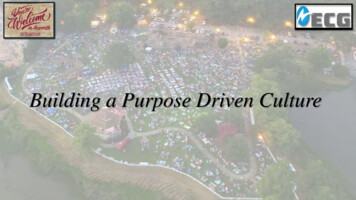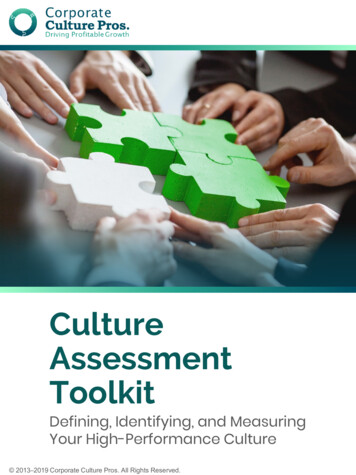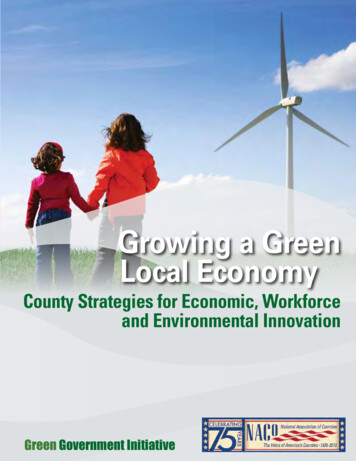
Transcription
BUILDING A CULTURE OFHEALTH THROUGH CROSSSECTOR COLLABORATIONMelvin J Houser, Auditor, Pottawattamie County, IA.Julie Willems Van Djik, Director of the County HealthRankings & Roadmaps ProgramPatricia Harrison, Deputy County Executive, FairfaxCounty, VA.Kevin Schiller, Assistant County Manager, WashoeCounty, NV.
BUILDING A CULTURE OF HEALTHTHROUGH CROSS-SECTORCOLLABORATIONJulie A. Willems Van Dijk RN, PhDDirector, County Health Rankings & RoadmapsNACo Legislative ConferenceFebruary 27, 2017
4
5
WHERE’S DALLAS?6
DIRECTIONA shared understanding of common goals and strategy7
ALIGNMENTResources and activities of the groups are coordinated8
COMMITMENTMembers value the collective success as much or more thanthey value the success of their own group.9
www.countyhealthrankings.org10
ACKNOWLEDGEMENTS‣ Robert Wood Johnson Foundation‣ Wisconsin County Health Rankings & Roadmaps Team‣ Our Partners–Including National Association of Counties and the Center forCreative Leadership11
THANK YOUJulie Willems Van Dijk RN PhDAssociate Scientist & DirectorCounty Health Rankings & RoadmapsUniversity of Wisconsin Population Health Institute608-263-6731willemsvandi@wisc.edu12
Building a Culture of Health throughCross-Sector CollaborationNACOFebruary 27, 2017
The Local Public Health SystemNon-Profits /CBOs
Evolution of Whole Community Planning Efforts Agency specific strategic plans– Individual agencies and organizations working on the sameissues narrowly focused on the agencies needs Community Plans focused on specific issues– Many boards, authorities, task forces, committees, work groups,all working, at times on similar issues but limited coordinationand limited agreement on goals and outcomes sought Systems Transformation and Collective Impact– Policies, services and practices are aligned across multipleagencies in order to achieve common goals and produce resultsneeded at the individuals, family, community and county level15
The Equitable Growth Profile revealed disparity inopportunity across county This Child Opportunity Indexis a composite of indicatorsincluding: Educational opportunity Health and environmentalopportunity Economic opportunity Overall opportunity is highacross the County relative toDC metro region, but thereare differences acrosscommunities within theCounty.Source: The datadiversitykids.org project and the Kirwan Institute for the study of Race andEthnicity16
Fostering a Sustainable Culture of Health Community Health Dashboard
Commitment to Equity Adopted by the Fairfax County Board ofSupervisors on July 12, 2016 Adopted by the Fairfax County School Boardon July 28, 2016The time is now to move beyond embracing diversityas an asset and implement a new growth modeldriven by equity – just and fair inclusion into “OneFairfax,” a community in which everyone canparticipate and prosper. The resolution directs the development of aracial and social equity policy to be applied inthe planning and delivery of all publicservices Through the use of equity tools the countyand schools will ensure that decisions aremade and resources are allocated within thecontext of One Fairfax, implementing policies,practices, and programs that will not justeliminate identified gaps, but increase successfor all.18
Community Leadership Engagement
Collective Impact Approaches WorkCommunityEngagementEquity LensStrategic andAccountablePartnershipsOrganizational andStrategic CapacityShared DataUseContinuousCommunicationPolicy andSystemsInfluenceSustainableFinancingThe elements of ourCollective Impact approachcreate a cycle of mutually beneficial andreinforcing practicesMore and better results can be achieved whenindividuals and organizations pool resourcesand work together. When everyone commits toa collective impact approach, the benefits to thecommunity are manifold:1) Inequities more easily identified andaddressed2) Data shared to evaluate effectiveness acrossmultiple organizations3) Gaps and redundancies in services identifiedto improve use of precious resources4) Partners broadly support and promote eachothers’ services5) Policy makers better-informed on communitywide progress and needs6) Communication between front-line,neighborhood-level partners and residents, andthe systems administrators and policy makersbetter facilitated
Fostering a Sustainable Culture of Health Successful Children and Youth Policy Team (SCYPT)– Coordinates policy, strategic activities and identifies resources toensure all children have opportunities to succeed Areas of focus – early childhood readiness, systems of care/supportingbehavioral health, opportunity neighborhoods, Members – Board of Supervisors, School Board, county, public safety andschool leadership, community leaders, foundations, health systems,nonprofits, business, parent, youth Opportunity Neighborhood– Coordinates the planning, implementation of community drivengoals to ensure youth have opportunities to succeed– Members: County, Schools, Public Safety, Community,Nonprofits and local business21
Fostering a Sustainable Culture of Health Domestic Violence Prevention and Protection Coordinating Council(DVPPCC)– Coordinates policy, strategic activities, legislation advocacy and adoptsevidenced based service and public information approaches Areas of focus – assessment, community education, trauma informed services,community capacity building Members – Board of Supervisors, Judges, human services, public safety and schoolleadership, faith leadership, health systems, nonprofits Diversion First– Coordinates policy, strategic activities, advocacy, practice changes, and totalsystems transformation to reduce the number of people with mental illness injail Areas of focus – supporting mental health needs and basic life needs for people withserious mental illness outside of jail who have had a low level crime incident andsupport transitions from jail or court services to maximize success in community Members - Board of Supervisors, Judges, county executive leadership, court and legalservices, human services, public safety, and school leadership, supported housing,faith leadership, health systems, nonprofits, people with lived experience, familymembers22
Fostering a Sustainable Culture of Health Equity Leadership Team– Oversees the development of policy and identifies resources neededto support the joint County/School adopted One Fairfax Resolution forracial and social equity– Members: County and School executive leadership, Dept ofTransportation, Dept of Planning and Zoning, Park Authority, Dept ofNeighborhood and Community Services, Dept of Housing andCommunity Development, Human Services, Student Services Economic Development Advisory Group– Strategic Plan to Facilitate the Economic Success of Fairfax Countysupports a comprehensive approach to creating and growing thecounty’s economic opportunities to enable full participation in thecounty’s economy– Incorporates “Health in All Policies”, social equity, land use,transportation and job skill development to integrate conceptspromoting healthy living with a focus on placemaking,23
Fostering a Sustainable Culture of Health Expansion of Tobacco Free Play Zones policy to picnicshelters, marinas, trails and amphitheaters. Comprehensive Policy Plan Review - incorporates PHlanguage for land use, transportation, housing,environment, economic development, heritageresources, public facilities, human services, parks andrec, revitalization and visual and performing arts. Food Council – coordinates strategies to ensure allareas of the county have access to healthy foods andsupports school programs, emergency food coops,farmers markets, and grocery store placements
Implementation in Action:Healthy Community Design Summit25
Implementation in Action:Health Impact AssessmentRichmond Highway Transit Center Provided recommendations to support positive healthoutcomes, avoid harmful health impacts, and promotehealth equity Team members included: Health Department Dept. of Transportation Dept. of Neighborhood and CommunityServices Dept. Housing and Community Development Park Authority Partnership for a Healthier Fairfax (PFHF)
Implementation in Action:Tobacco Free Environments Successfully worked with FairfaxCounty Park Authority to developa message that would establishTobacco-free Play Zones FCPS adopted similar policy 1,300 public playgrounds, athleticfields and skate parks27
Challenges and Solutions Ensure equitably distributed leadership and voice– Balance a multi-sector approach with adequate representation andparticipation– 1/3 county leadership, 1/3 school leadership, 1/3 community leadership– Represented elected officials from both County and Schools Commitment to develop and prioritize strategies and funding– Check all strategies against the goals and strategies agreed upon by theleadership– Use trend and programmatic data to verify need and assess effectiveness Effectively communicate with members, stakeholders, and thepublic– Use online resources to enable efficient use of leadership time - Listserv, openmeetings, and posting materials online– Develop reporting templates and standard messaging28
Benefits of Health in All Sectors ApproachA Collective Impact Provides a full vetting of proposals/initiatives before they reach theboards– Increases chances approval if strategies and funding areendorsed by one of the collective impact and policy teams– Provides a vehicle for board-initiated work Ensures initiatives have a comprehensive and multi-sectoralapproach– Helps knock down silos, as SCYPT won’t accept anything toonarrow Requires the use of data to drive decisions and recommendations– Enables “one voice” for prioritization of needs– Reduces unproductive effort resulting from misinformation29
Success Factors Not just leadership buy-in – cross sector leadership must be responsiblefor development of policy, resources, legislation advocacy, andtransformation of service systemsObtain agreement on goals, strategic approaches, policy frameworks - andcommunicate those goals broadlyCreate multi-year blueprint plans that enable multiple plans to beincorporated into one blueprint – pooling key strategies and resourceneeds from multiple work plans and task force recommendations reducesduplication of effort, enables coordination across sectors, enablesassessment of results, provides opportunities for universal collection ofdataPublicly post data that supports results and assesses effortsAdopt a common language and train, train, train the community andworkforce in use of language30
Contact InformationPatricia Harrison, Deputy County ExecutiveHealth & Human Services, Fairfax County, VirginiaStaff resource:Sharon Arndt, MPH, MPADivision DirectorCommunity Health Development and PreparednessFairfax County Health Department, Virginiasharon.arndt@fairfaxcounty.gov703-246-8753
Washoe County Social Services collaborated andpartnered with local government agencies andprivate organizations in bringing a solution to ourcommunity and citizens.
Additionally there are otherparticipating agencies that clarify andprovide additional direction for theclients. These agencies have been agreat support system for the client.The goal is to keep Crossroadsclients motivated to changebehaviors and keep recidivismreduced. The wrap-aroundservice offered by Crossroadsis all done here directly on campus.
WASHOE COUNTYCROSSROADS PROGRAM The Crossroads project provides an objective of housing first approach thattargets homeless individuals in Washoe County. The intent of the program is to identify, intervene and stabilize traditionally highrisk homeless individuals, through cooperation with various communitypartners. We offer an alternative to homelessness and incarceration by offering the toolsnecessary for anyone to be successful upstanding citizens of our communitywhile being drug and alcohol free. Our success has grown into reducing incarceration by expanding services toyoung offenders, and anyone else who suffers from mental health and/orsubstance abuse that otherwise has a negative impact on our community. Annual savings to community and all service providers of 15 million.
OUR CLIENTS Over 821 Clients since the Inception of the Program 130 24 Veterans Clients Currently in the program (153 CR beds 24 Veterans 177) Mix of Clients Almost all of our Clients Struggle with Addiction Almost all were Homeless at one point or incarcerated. 80% or greater have Co-Occurring Disorder (COD) They live on-site Cook their own Meals Do their own Laundry Maintain the Grounds and Assist with the Maintenance of St Vincent’s Daily household chores Community Volunteering35
To assist individuals indiscovering &developing theirmarketable talents togain meaningfulemployment.Using a variety oftechniques our LearnTo Earn departmenthas been successful inengaging clients insteady, gainfulemployment.CROSSROADS IS GIVING CLIENTS NEW SKILL SETS TOSTAY COMPETITIVE IN THE WORKFORCE USINGINNOVATION AND TECHNOLOGY
SOBER 24- CROSSROADS RESOURCE CENTER The Sober 24 program is a 24 hour, seven day a weekmonitoring program in which a participant submits to thetesting of their breath, urine or any other bodily substance inorder to determine the presence of alcohol or a controlledsubstance in their body. The program can be used both pretrialand post conviction. The goal of the program is to combat therole that alcohol and drug abuse play in crime and criminalrecidivism, particularly for drunk driving and/or drugged drivingto further reduce the number of DUI’s and related costs bymotivating offenders to change their behaviors. Resource Center- Outpatient Crossroads with onsite servicesfor substance abuse, mental health, case management, and socialservices.37
CROSSROADS AT INCEPTION -2010Gould Street 10beds38
CROSSROADS TODAY“THE POWER OF COLLABORATION”Sutro BuildingsGoal 150 bedsPark House24 VeteransRiver House31 womenFuture FamilyShelterTADS6th & MontelloSober 24 - Off CampusCrossroads1,000 clientsLewisSt.12 bedsGould104clients39
NATIONAL ASSOCIATION OF COUNTIES“BUILDING A CULTURE OF HEALTHTHROUGH CROSS SECTORCOLLABORATION”FEBRUARY 27, 2017
HOMELESSNESS & ADDICTION IMPACTSCommunity, law enforcement, fire, medics, hospital, detoxcenters, jails, courts and businesses
COST TO THE COMMUNITYThe average cost incurred to taxpayers for the client before coming toCrossroads were as follows: Average Cost per client 150.00 to 500.00 per day when homelessor in active addiction First Responders 1000 per incident Hospitals 10,324 in bill charges. Emergency Room visits etc. Jails and Booking 128 daily per bed, Booking cost is 180 per visit REMSA 1,267 in transports for medical attention. Over 700 timesfor clients at Crossroads before entering program. Treatment 100 per day (detox-centers, C.P.C., institutions) Victims hardships endured by victims range from 10,000 to 100,000 for each claim
HOW WE GOT STARTED Washoe County provided Cash Assistance andHealth Care Assistance at a cost of 29 million ayear. Entering recession took 10 most frequent usersof the system with an average individual cost of 150,000- 250,000. Costs resulted from incarceration, medicalservices, social services, mental healthservices, multiple jail stays of up to 40 arrestsand over 250 days. Utilized a model of social services and lawenforcement for joint intervention with CatholicCharities of Northern Nevada. Key was COLLABORATION and funding ofDeputy positions through Social Services.
CROSSROADS DRUG & ALCOHOL TESTINGPBT TestingYearTestsPositives201462,19359201575,00334 (99.9996% Passing Rate)Drug TestingYearTestsPositives2014414232015344038 (99.998% Passing Rate)44
BUILDING A CULTURE OF HEALTH THROUGH CROSS SECTOR COLLABORATION Melvin J Houser, Auditor, Pottawattamie County, IA. Julie Willems Van Djik, Director of the County Health Rankings & Roadmaps Program Patricia Harrison, Deputy County Executive, Fairfax County, VA. Kevin Schiller, Assistant County Manager, Washoe County, NV.










